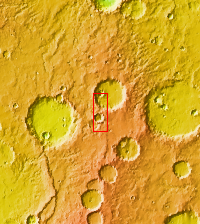
Context imageThis VIS image contains three craters. There is a quarter of the largest crater in the top half of the image, half of a smaller crater at the very top, and the full crater in the lower half of the image. Investigating the relative ages of each crater indicates the largest crater formed first followed at some point by the smaller craters -- the 1/2 crater at the top occurs on top of the big crater as does the ejecta from the bottom crater. Because the visible ejecta does not reach the smaller crater at the top it is difficult to determine the relative ages of the two smaller craters. Both have similar floor morphology, but different rim morphology. The crater in the bottom of the image has a very complex rim, including both rim gullies (top side) and ridge and spur eroded features (bottom side). These difference may be related to the different materials of the largest crater. One crater impacted into the floor and the other into the ejecta blanket of the largest crater. Near surface morphology as well as deeper materials can modify the pressure wave created by impact. These craters are located in Terra Cimmeria.
Orbit Number: 75334 Latitude: -38.7393 Longitude: 157.653 Instrument: VIS Captured: 2018-12-08 06:01
Please see the THEMIS Data Citation Note for details on crediting THEMIS images.
NASA's Jet Propulsion Laboratory manages the 2001 Mars Odyssey mission for NASA's Science Mission Directorate, Washington, D.C. The Thermal Emission Imaging System (THEMIS) was developed by Arizona State University, Tempe, in collaboration with Raytheon Santa Barbara Remote Sensing. The THEMIS investigation is led by Dr. Philip Christensen at Arizona State University. Lockheed Martin Astronautics, Denver, is the prime contractor for the Odyssey project, and developed and built the orbiter. Mission operations are conducted jointly from Lockheed Martin and from JPL, a division of the California Institute of Technology in Pasadena.

